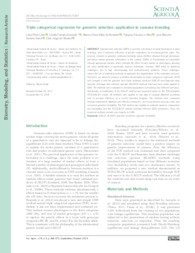Triple categorical regression for genomic selection: application to cassava breeding.
Triple categorical regression for genomic selection: application to cassava breeding.
Autoria: LIMA, L. P.; AZEVEDO, C. F.; RESENDE, M. D. V. de; SILVA, F. F. e; VIANA, J. M. S.; OLIVEIRA, E. J. de
Resumo: Genome-wide selection (GWS) is currently a technique of great importance in plant breeding, since it improves efficiency of genetic evaluations by increasing genetic gains. The process is based on genomic estimated breeding values (GEBVs) obtained through phenotypic and dense marker genomic information. In this context, GEBVs of N individuals are calculated through appropriate models, which estimate the effect of each marker on phenotypes, allowing the early identification of genetically superior individuals. However, GWS leads to statistical challenges, due to high dimensionality and multicollinearity problems. These challenges require the use of statistical methods to approach the regularization of the estimation process. Therefore, we aimed to propose a method denominated as triple categorical regression (TCR) and compare it with the genomic best linear unbiased predictor (G-BLUP) and Bayesian least absolute shrinkage and selection operator (BLASSO) methods that have been widely applied to GWS. The methods were evaluated in simulated populations considering four different scenarios. Additionally, a modification of the G-BLUP method was proposed based on the TCR-estimated (TCR/G-BLUP) results. All methods were applied to real data of cassava (Manihot esculenta) with to increase efficiency of a current breeding program. The methods were compared through independent validation and efficiency measures, such as prediction accuracy, bias, and recovered genomic heritability. The TCR method was suitable to estimate variance components and heritability, and the TCR/G-BLUP method provided efficient GEBV predictions. Thus, the proposed methods provide new insights for GWS.
Ano de publicação: 2019
Tipo de publicação: Artigo de periódico
Unidade: Embrapa Florestas
Observações
1 - Por padrão são exibidas publicações dos últimos 20 anos. Para encontrar publicações mais antigas, configure o filtro ano de publicação, colocando o ano a partir do qual você deseja encontrar publicações. O filtro está na coluna da esquerda na busca acima.
2 - Para ler algumas publicações da Embrapa (apenas as que estão em formato ePub), é necessário ter, no celular ou computador, um desses softwares gratuitos. Sistemas Android: Google Play Livros; IOS: iBooks; Windows e Linux: software Calibre.
Acesse outras publicações
Acesse a Base de Dados da Pesquisa Agropecuária (BDPA) para consultar o acervo completo das bibliotecas da Embrapa.

